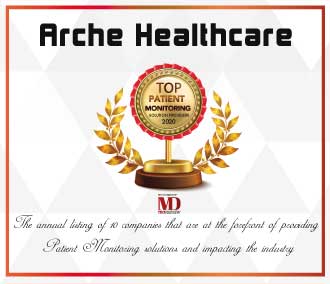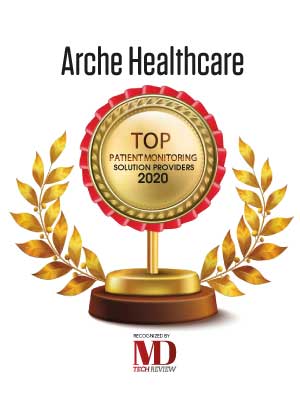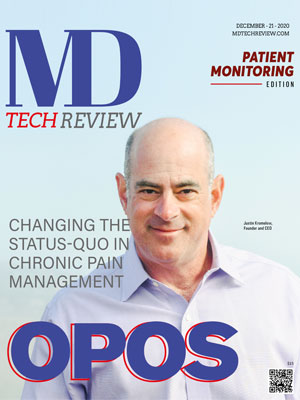 Scott Kantro, DPM CEO
Scott Kantro, DPM CEOThis is where companies like Arche Healthcare, a leading population health management (PHM) provider for diabetic foot health, comes into the picture. The company provides state-of-the-art, patient-centered diagnostic and engagement tools, combined with a standardized risk stratification process, which allow for timely interventions to reduce diabetes-related lower extremity wounds and amputations.
In a conversation with the editorial team at MD Tech Review, Scott Kantro, DPM, the CEO of Arche Healthcare, discusses how his company is transforming diabetic foot care and improving the prevention of lower-extremity amputation through cutting-edge technology.
Could you provide us an overview of your company?
Diabetic conditions that affect the lower extremities can be complicated and expensive. Foot ulceration and amputations are physically, emotionally, and financially catastrophic for patients. About 34 million people suffer from diabetes in the U.S., and probably another 88 million from what is termed as pre-diabetes. Studies indicate that the direct costs associated with diabetic limb complications exceed $60 Billion annually. The cost of treating wounds is over $44,000, and the cost of amputations that result from these wounds is over a staggering $60,000.
Arche's population health management strategy has been specifically architected to reduce these diabetes-related wounds and amputations by up to 54 percent. We are all about the patient, and they are the cornerstone of any successful preventative program. Our programs and tools are trusted by leading clinicians and informed by the latest evidence-based research on diabetic foot health and validated by the Validation Institute.
Arche's patient-centered tools put the problems in front of the patients. Our advanced IT platforms and diagnostic devices are predicated on a “seeing is believing” and “show and tell” approach. Our insightful near real-time analytics into the diabetes-affected population that we are measuring has created a paradigm shift in diabetic foot care. Arche has assembled some of the biggest luminaries in the world of diabetic foot care with one common purpose — to help make a smarter patient. A smarter patient is a better patient as it allows them to recognize the risks involved and adopt a preventative approach to wound care.
How has the pandemic affected the lower extremity diabetes care space?
The COVID-19 pandemic has accelerated the need to extend patient care beyond the walls of the clinic and, at the same time, created a great opportunity for remote patent monitoring. There has been a tsunami of diabetic foot wounds and amputations as people aren't visiting the clinic. Further, the African American, Hispanic American, Native American, and Asian American population groups are more vulnerable to diabetes and diabetic lower extremity complications and have the least economic means to gain access to care and these problems are multiplying exponentially. Dr. Paul Brand once said that pain is one of God's great gifts to us. When the patient doesn't feel pain, they don't know that something is wrong. As the majority of diabetes patients suffer from neuropathy, they do not feel any pain.
For Arche, it all boils down to putting the problem in front of the patient to increase their health literacy so that they take better care of themselves and strictly adhere to treatment plans
Lower extremity complications are increasing at an alarming rate among Americans. At some point in their lives, 34 percent of people with diabetes will develop a foot wound, and 3.8 percent of those will lead to an amputation. The most startling fact is that 40 percent of those that develop a wound will reulcerate in the first year and 65 percent will reulcerate within five years. The mortality rate of this population is 45 percent at 5 years. These facts highlight the need for programs like the Arche Healthcare CLUE program. Our CLUE program has been specifically developed for the payor community and is based on lower extremity amputation prevention. Our mission is to demonstrate improvements and reduction in the incidence of ulcers and amputations in diabetes patients — essentially, a lower extremity amputation prevention (LEAP) strategy. In this regard, we have noticed that now more than ever, payors are incentivizing providers to produce and maximize better outcomes.
We are focused on developing an effective population health management solution that uses data to identify gaps in care, apply standardized processes, procedures, and protocols. At the same time, we are creating an ecosystem of patients, providers, pharmacists, and everyone involved in diabetic foot care. We have to use evidence-based medicine and measure outcomes better to drive practice. To this end, we equip podiatrists, MDs, and DOs in the Arche LEAP Collaborative program with technologies and proprietary software. Our tools are novel and unique to us, either developed by us or licensed in an exclusive arrangement with some of our associates.
We use insights from the Arche LEAP Collaborative as a population baseline. Arche provides a dashboard — OPTYX — for the people participating in the collaborative program that maintains a registry of all the diabetes patients, their wound history, and amputation history, all sourced from their EMR/EHR. Our OPTYX dashboard is well equipped and uses insightful near-real-time data to manage and measure populations. It allows a podiatrist to easily view the historical data of a patient and make informed decisions.
How do you engage your patients to make them aware of the implications of their health condition?
Renowned British physician, James Alexander Lindsay once said, “For one mistake made for not knowing, ten mistakes are made for not looking.” A typical diabetic foot assessment includes only cursory neurologic, vascular, and dermatologic examinations, which are just not enough. That's why we came up with the Arche Comprehensive Diabetic Foot Exam (CDFE). It creates unique visual cues that actively engage the patient in understanding their risk for developing diabetic foot complications and empower them to own their care plan. Using Arche’s proprietary tool, PressureStat, the podiatrist can measure areas of increased focal plantar pressure and demonstrate to their patients those areas that are at highest risk for developing a foot wound, using the patient’s own footprint for illustration. Similarly, our easy-to-use digital skin moisture meter — DermaStat — accurately detects the “tell-tale” moisture levels of the skin’s surface, providing an alert to the potential effects of excessively dry skin of the feet that may lead to more complicated dermatological conditions and wound formation, especially in a diabetic person. For Arche, it all boils down to putting the problem in front of the patient to increase their health literacy so that they take better care of themselves and strictly adhere to treatment plans.
Could you describe the applications of your InFocus kit?
We engage and equip patients to actively participate in their ongoing plan of care and manage their risk at home with our InFocus Kit. The InFocus program provides each member with a remote monitoring system, including different devices that can be paired with an app called “VeriSole” to help podiatrists and members monitor the condition of their feet. Their foot health data is securely transmitted from VeriSole to OPTYX. With our OPTYX dashboard, we connect the doctor to the patient. The podiatrists can engage in shared decision-making with their patients by following-up when indicated to discuss the need for an appointment.
The kit also includes TempStat, an easy to use and visually compelling FDA-approved, at-home temperature monitoring device. It uses liquid-crystal technology to produce a thermal image of a patient's feet to allow for quick and easy identification of potential hotspots. Our InSight device utilizes the same liquid-crystal technology as TempStat and replaces the mirror with a scanning device that captures a high-resolution image of a potential hotspot. Next, DermaStat accurately detects the skin moisture levels of their feet and provides an alert for the potential impact of excessively dry skin.
When it comes to lower extremity diabetes care, one size does not fit all. Patients can be classified depending on the level of the potential risk, level zero to level three, zero being the lowest and three being the highest. Based on this classification, we recommend a combination of these devices.
What does the future hold for Arche Healthcare?
Our goal is to help practitioners and healthcare providers go from good to great. We have global aspirations, and we are working in the U.K. and Australia to extend our programs to the population in these countries. We are all excited to work alongside the University of Miami Leonard M. Miller School of Medicine for further studies in the field of lower extremity diabetes care.
Company
Arche Healthcare
Headquarters
New Canaan, CT
Management
Scott Kantro, DPM CEO
Description
Reduces costs and preventing diabetes-related lower extremity wounds and amputations with state-of-the-art, patient-centered diagnostic and engagement tools, combined with a standardized risk stratification process





